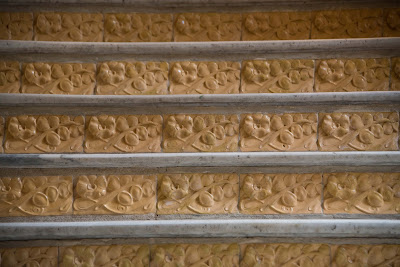The Hospital de Sant Pau and the Palau de la Musica Catalana, both created by architect Lluis Domenech i Montaner in the Art Nouveau style of his time, are great artistic and cultural treasures not to be missed in Barcelona. The Hospital was a short walk from the Sagrada Familia but had far fewer visitors so it was the perfect place to escape from the crowds in and around the basilica. It was a peaceful haven and built with that idea in mind. The hospital complex was built as an independent isolated site, "a city within a city", with an area of 145 square metre per patient, including the landscaped grounds - a concept unheard of at the time (1930). The complex was made up of 27 pavilions (16 were modernista), each with a specific medical specialty and linked to each other through underground galleries.
Materials chosen were the best, including brick, colourful clay tiles, glazed ceramic or decorated stone, ceramic mosaic, wood, marble, glass, metal and iron, to create pleasant natural surroundings for the patients. Not just functional, the hospital was a work of art. You can see from the photos below what an exceptional hospital environment this was.
The Palau de la Musica Catalan was not just an architectural jewel, it was also a "symbolic emotional heritage" for the people of Catalonia. The building brought together all the decorative arts: sculpture, mosaic, stained glass and ironwork. Guided tours were offered but we purchased advanced tickets for a concert at the Palau to fully experience the venue. We lucked out as the week that we were in Barcelona, there happened also to be a concert commemorating the 50th anniversary of Habaneras in Calella (a seaside town near Barcelona). We enjoyed an evening of lovely singing and also participated in a bit of nationalistic expression - everyone was given white kerchiefs to wave along with the choirs on stage for the grand finale. Lots of fun even though we have yet to figure out what the white kerchief signified although it was clearly an expression of support to wave it together!
I am also happy to report that despite all the warnings of thefts and pickpockets in the city, we were able to walk back unmolested to our hotel from the Palau after the concert. We felt safe because there were lots of people on the street at night - of course, we were also lucky...
 |
| The front of the Hospital de Sant Pau faced the Avenue de Gaudi, a straight line to the Sagrada Familia. The photo below is a view of the Sagrada Familia through the front portal of the Administrative Pavillion, framed by the reflection of another building in the portal glass. |
 |
| We entered through the basement - these were the decorated steps leading to the upper level |
 |
Beautifully kept gardens were part of the planned concept - a new one at the time since open-air areas for patients' enjoyment and wellbeing were regarded then as unnecessary. Here the architect designed two gardens per pavilion. The plants and trees served the purpose of purifying the air and also modifying the weather.
 |
Beautifully decorated pavilions
 |
| The magnificent foyer of the Administration Pavilion and the stained glass cupola over the stairs (below) |
 |
| The Dominech i Montaner Room, formerly the main hall of the hospital: convergence of a host of artistic disciplines - architecture, sculpture, stained glass, mosaic, ceramics and painting |
 |
| The Palau de la Musica Catalana |
 |
| Beethoven frowning down upon the street |
 |
| The grand stairs in the foyer |
 |
Stained glass everywhere |
 |
| Lluis Millet Hall - the double colonnaded balcony could be seen through the stained glass windows |
 |
| The main concert auditorium |
 |
| The skylight in the auditorium portraying the sun |

Mosaic covered columns
 |
| Waving the kerchief with the performers at the concert celebrating the 50th anniversary of Habaneras in Calella |
 |
| Customers waiting to get in to Tosca, just across the street from the Palau, as we were leaving the concert - we had great tapas here before the show. |
























































